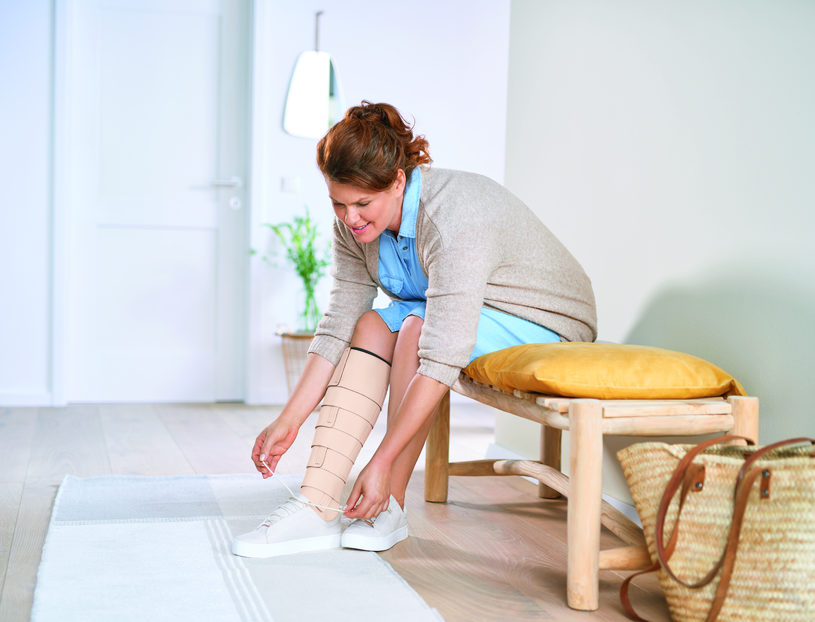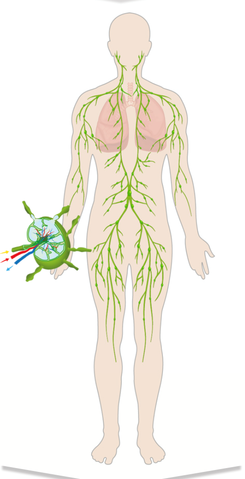Lymphoedema
What is the Lymphatic System?
The Lymphatic System is a network of vessels, lymph nodes and lymphatic organs that circulates protein-rich fluid, called lymph, throughout the body. Its main job is to collect proteins from the tissue and return to the blood; collect bacteria, viruses and waste, then flush them out of your system. The system is an essential part of your immune system and crucial to keeping your body healthy.
What is Lymphoedema?
Lymphoedema is a swelling that occurs when a blockage or malformation in your Lymphatic System prevents the lymph fluid from draining adequately throughout the body. This can occur anywhere from head to toe.
There are two different types of Lymphoedema: Primary and Secondary. Both cause swelling, mostly in the arms or legs, but have different causes.
What is Lymphoedema?
Overview
Primary Lymphoedema can be hereditary, but you could also be the first one in your family to develop it. It can either begin at birth, develop during childhood or occur later in life.
Secondary Lymphoedema is more common and is often caused by surgery after lymph nodes are removed. It can also be the result of cancer, cancer treatment, infections or injury.
Symptoms
Everyone’s symptoms are different and can be more, or less, severe depending on the stage of the condition. Here are some typical indicators to look out for:
- Progressive swelling of part of your body (typically in arms or legs)
- A feeling of heaviness or tightness in the suspected area
- Restricted range of motion
- Aching, pain, or discomfort
- Recurring infections
- Hardening, reddening and/or thickening of the skin
- Skin on the fingers or toes can become squared in appearance as they swell
- It becomes difficult to see the tendons/bones/veins in your hands or feet

There are many different conditions and circumstances that can cause your limbs to swell. That’s why it’s important to make sure you get the right diagnosis.
Your care provider will ask you to provide your medical history, detailing any current medications, and will give you a physical examination to establish a diagnosis.
In some cases, specialized imaging tests will be ordered to confirm the diagnosis, which may include CT or MRI scans, Doppler ultrasound or Lymphoscintigraphy – a special type of nuclear medicine imaging that provides pictures call scintigrams of the lymphatic system.
After diagnosis, always ask to see a qualified Lymphoedema Specialist and find out as much as you can about them before your appointment. Ask to see their qualifications and check that the therapist is specifically trained in lymphatic and venous impairments.
Lymphoedema isn’t curable, but there are many things you can do to manage your swelling and prevent your symptoms from getting worse. We can help you find the right treatment and support to manage your condition and live life to the fullest.
- Keep an eye on any abnormal swelling, changes in feeling, color or skin condition
Watch your weight. You can see if you are within a healthy range by calculating your BMI (link to wt/BMI/bmicalc.htm NIH BMI calculator)
- Try to avoid injury to the affected area
- Avoid tight-fitting clothing
- Keep your arms or legs clean
- Wear your compression garment as directed by your Lymphoedema Therapist
If you have Lymphedema, you’re at risk of developing certain complications:
- Bacterial infections – Cellulitis, a potentially serious infection and Erysipelas, a superficial infection with a distinctive rash. Both are common and usually cause redness, swelling, pain and warmth.
- Fungal infections – An itchy, bumpy red rash, odor usually found between the toes or folds of skin.
- Lymphangitis – An inflammation that occurs when bacteria enters the lymphatic channel.
- Lymphangiosarcoma – A rare form of soft tissue cancer that, occurs from long standing lymphedema and appears as blue-red or purple marks on the skin.
It’s important to keep an eye on any changes, to prevent potentially serious infections from developing. It might help to keep a diary of your condition and show it to your care provider.
Causes
Primary Lymphoedema can be a hereditary condition:
A disease that is inherited where the lymphatic vessels don't form properly in the womb. Symptoms are present at birth or within the first year of life.
A hereditary condition that causes lymph vessels malformation. This typically begins during childhood or puberty.
A less common condition is lymphoedema that occurs after the age of 35.
Secondary Lymphoedema is often caused by:
Sometimes, lymph nodes or vessels must be removed, or they are damaged during surgery. This is common in cancer surgeries (i.e. breast cancer) to determine if the cancer has spread.
Cancer cells or tumors growing near lymph nodes or vessels can cause blockages, preventing the lymph fluid from draining properly.
This may cause scarring or inflammation of the lymph nodes or vessels, restricting lymph flow.
This type of Secondary Lymphedema is called Filarial Lymphedema. It is most found in tropical regions from around the world such as India, China, or Indonesia, Asia, Africa, the west pacific, parts of the Caribbean and South America.
Anything that damages lymph nodes or lymphatic vessels may also compromise the lymph system, causing Secondary Lymphedema.
If you feel that you may be at risk for Secondary Lymphoedema, please see your therapist or doctor for more information and get advice from The National Lymphoedema Network. Visit https://lymphnet.org/ for more information.
Stages
There are four stages of Primary and Secondary Lymphoedema. Your treatment plan will be different, depending on whether you are in stage 0, 1, 2 or 3.
No swelling (Latent Stage)
No evidence of swelling, even if lymphatic system has been disrupted. Lymph nodes may have been removed and or radiation; therefore, a person is a risk of developing lymphoedema but has not yet developed it.
Mild swelling – (Reversable Lymphoedema)
Slight swelling that is intermittent. It may go down when the limb is elevated.
Management: Education, simple- or self-lymphatic drainage, compression garment, exercise and skin care
Moderate swelling – (irreversible Lymphoedema)
Moderate swelling that doesn’t get better with elevation start of skin/ tissue changes
Management: Education, manual lymphatic drainage, compression bandaging, compression garments, skin care, exercise and self-management tools.
Severe swelling – (Lymphostatic Elephantiasis)
Severe swelling, accompanied by skin changes, such as fibrosis and hyperkeratosis.
Management: Education, manual lymphatic drainage, compression bandaging, compression garments, skin care, exercise and self-management tools.



